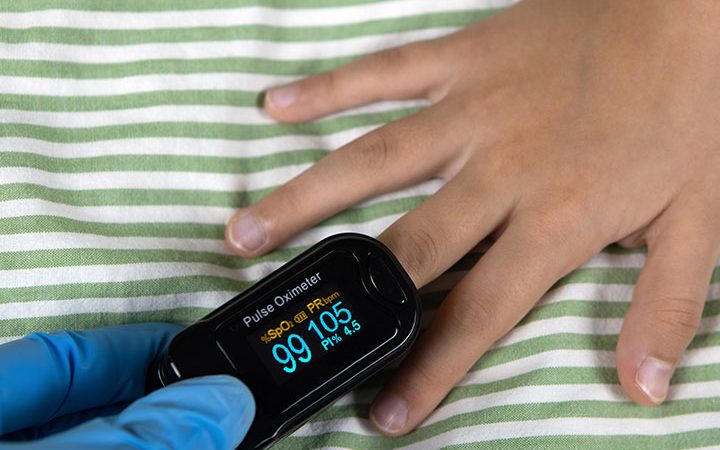A respiratory rate is defined as the number of breaths taken per minute. It varies according to the age and medical condition of a person. In addition, many factors, such as blood pressure, physical activity, body electrolyte level, and body temperature, alter the respiratory rate (1).
Respiratory rate is a vital sign of the human body as it indicates the functioning of the lungs. An altered breathing pattern could indicate a health condition. This is why it is important to know the normal respiratory rate for children and the factors affecting it. This post presents more information on the normal respiratory rate for children and when to be concerned about it.
Normal Respiratory Rate For Children
The table illustrates the normal ranges of the respiratory rate of children (2).
| Age | Respiratory Rate (breaths/min) |
| Infant (birth-1year) | 30-60 |
| Toddler (1-3 years) | 24-40 |
| Preschooler (3-6 years) | 22-34 |
| School-Aged Child (6-12 years) | 18-30 |
| Adolescent (12-18 years) | 12-16 |
Source: The University of Iowa and Stead Family Children’s Hospital
Measuring Respiratory Rate In Children
Measuring the respiratory rate in children is an easy task as it can be done using observational cues. The rise in the chest indicates inhalation, while a fall signifies exhalation. Therefore, you would measure one rise and one fall of the chest as one complete respiratory cycle. Here are the steps to follow (3).
- Ensure your child sits in an upright position
- Set your timer to one minute
- Start the timer and note down the number of chest wall movements
- After a minute, compare the count with the standard chart
Do not conduct the test after any strenuous activity to avoid any discrepancies in the count. Similarly, do not let your child know that they’re under observation as they may consciously alter their breath in such observational or clinical settings. Alternatively, you may use a respiratory sensor to avoid any mistakes.
Reasons For Altered Respiratory Rate In Children
Irregular breathing is when a child’s breathing rate is higher or lower than the acceptable ranges for their age. The reasons may include the following (4) (5).
1. High respiration rate
- Dehydration: Tachypnea (abnormally rapid breathing) is a sign of severe dehydration among children (6).
- Respiratory illnesses: Any underlying lung conditions could result in an increased respiration rate. Asthma, chronic obstructive pulmonary disease (COPD), pneumonia, emphysema, or other lung infections could be the reasons.
- Fever: It is the most common cause of increased respiration rate in children. This increase in breathing rate is a part of the body’s mechanism to get rid of the excess body heat (7).
- Anxiety: Panic attacks may cause a child to hyperventilate. This fast breathing rate would recede on its own as the child calms down from the anxiety attack (8).
- Heart conditions: Heart and lungs work in conjunction. Hence, any cardiovascular health issues that affect the pumping of blood may affect the lungs eventually. The lungs may compensate for this decreased heart function by increasing the respiration rate.
2. Low respiration rate
- Overdosage: Certain narcotics, especially opioids prescribed for pain management for children, may affect the respiratory rate. An overdose of opioids could result in respiratory depression (9) (10).
- Obstructive sleep apnea: Pediatric obstructive sleep apnea is a sleeping disorder occurring due to an obstruction in the airway during sleep. In this condition, the child may show decreased or frequent pauses in breathing while asleep (11).
- Brain injury: Since the brain and lungs share a reciprocal relationship, respiratory dysfunction is a common complication of a brain injury (12).
Metabolic disorders, such as hyperthyroidism or hypothyroidism, may affect breathing patterns, too. While hypothyroidism decreases the respiratory rate, hyperthyroidism increases it (13). Altered respiratory rates could have benign causes, too. For example, an increased respiratory rate after intense physical activity is common.
When To See A Doctor
A breathing rate of more than 40 breaths per minute for a child of 1-12 years or more than 20 breaths for a child older than 12 years indicates irregular breathing patterns. Fewer than 12 breaths per minute could also be a sign of a problem.
Erratic respiration rate due to a problem is mostly accompanied by other signs of respiratory distress. It may help parents determine if the change in respiration rate is normal or due to an underlying condition. Below are some of the notable signs of respiratory distress in children (14) (15) (16).
- Increased heart rate: A rapid heart rate could be observed with a decrease in oxygen levels in the body.
- Stridor: A high-pitched, wheezing sound that is audible every time the child tries to inhale. It could be an indication of an obstructed airway.
- Blue color change: If the color of the skin is turning blue, it is an indication that the body isn’t receiving sufficient oxygen. This blue color would be more evident near the mouth, inside of lips, and nails.
- Grunting: A grunting sound paired with deep breaths indicates respiratory trouble.
- Use of accessory muscle: The muscles of the neck appear strained during inhalation.
- Flared nostrils: Nostrils open wide during each inhalation if the child is facing issues breathing.
- Chest retractions: The chest may keep sinking deeper with each breath.
- Decreased alertness: Low oxygen supply to the brain may result in fatigue and decreased response to verbal cues.
These medical conditions are an emergency and indicate a severe respiratory problem, and require immediate medical intervention.
The measurement of the rate of breathing doesn’t need any advanced tools, and you could check if your child is uncomfortable or faces any breathing issues at home easily. The respiratory rate for children varies as they age. Nevertheless, it is important to know their breaths per minute as this sign is as crucial as heart rate or blood pressure.
References:
MomJunction’s articles are written after analyzing the research works of expert authors and institutions. Our references consist of resources established by authorities in their respective fields. You can learn more about the authenticity of the information we present in our editorial policy.
Recommended Articles
The following two tabs change content below.




































